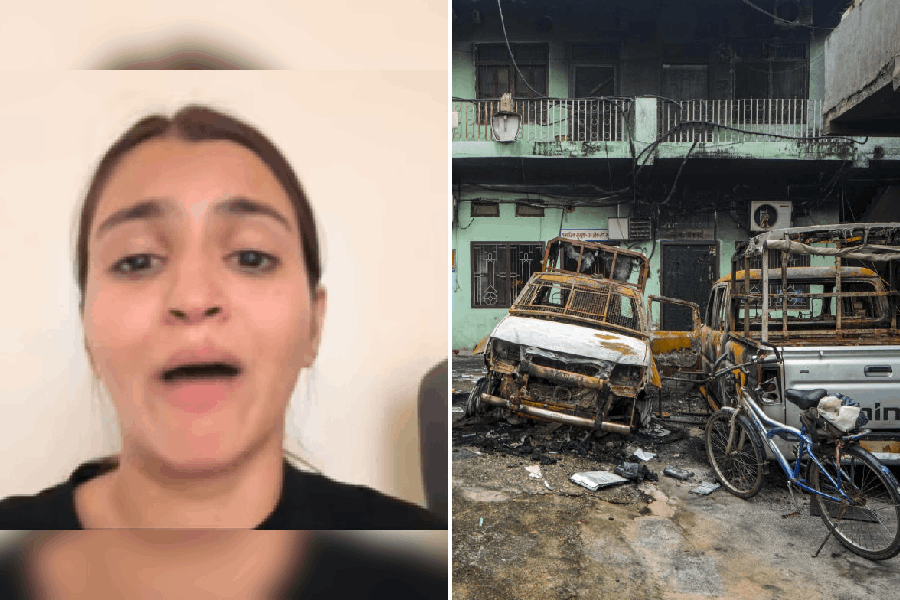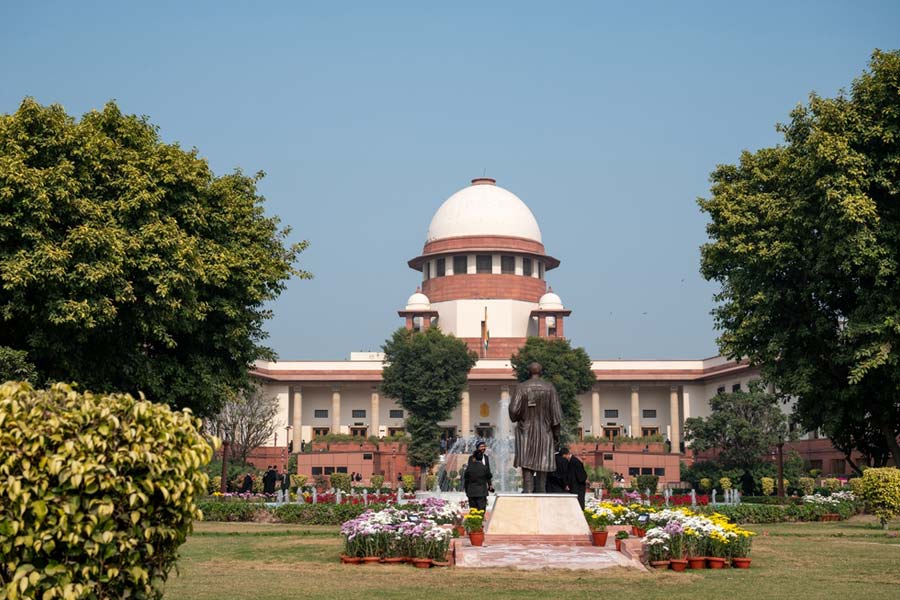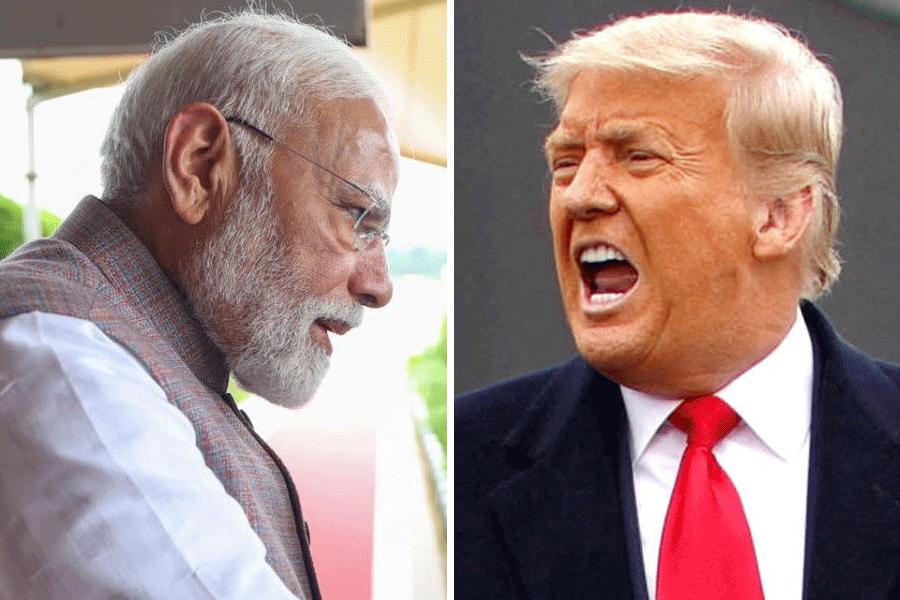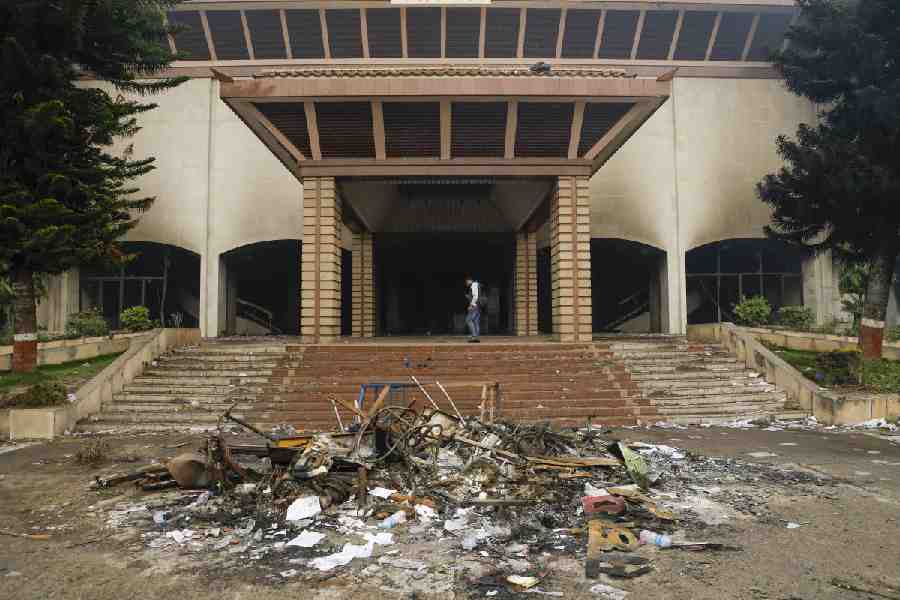 |
| Plush, March 2009. Picture by Rashbehari Das |
It’s 11.30 on a Wednesday night at one of Calcutta’s most popular lounges and nightspots. As one enters, one meets the usual crowd of young men and women waiting for their drinks around the bar. The DJ turns out peppy numbers and a slim girl in jeans and a top with cut-away sleeves begins to shake to the beat. There is a younger crowd, nearer to the DJ, doing some energetic grooving. You’ll have to scream in your companion’s ear to make yourself heard. As you are about to do that, you may stop suddenly as you catch a middle-aged “aunty” looking disapprovingly at you from a nearby table.
There she sits at a table just opposite the door, in a kalamkari salwar-kameez, looking a little bewildered. She is in a big group of middle-aged men and women, which could be friends or family. One lady in the group, the most daring one, is in a sleeveless tunic. A group of men sits in another corner. One of them has a towering paunch, one has salt and pepper hair. Some of their eyes linger on the young things. The light is none too bright, but you wish it were darker.
 |
| Anticlock, July 1997 |
Another lounge bar, Park Street, midnight. A beautiful woman in her mid-30s sits on one of the sofas with her husband, as a group of college kids keeps the decibel level up at the other end of the room. In her green, heavily embellished chiffon sari and kundan jewellery she would have turned heads at any wedding.
A curious remix is on offer at nightclubs in Calcutta. Blame it on the recession or the city’s economy — instead of worshipping youth and beauty, to survive, they want “family”. They want to be all things to all people.
Family matters
“We want to include the family crowd. We don’t get too many of them during the week, but we do get a percentage of them during the weekend,” says Sovan Mukherjee, the F&B manager of Shisha, one of the most popular lounge bars in town. The wooing of the “family” crowd is universal. Several other nightspots — Soho, Venom, Privy, Plush — are all doing that.
“Plush is a lounge bar where one can come with family and friends and have a good time,” says Ekta Puri of Plush at The Astor hotel. “We are aiming at the 25+, but since we have a very extensive food menu even a 15-year-old can come with the family for a good meal,” she adds.
As the night progresses, around 10.30-11pm, the place becomes more of a nightclub, the mood changes and so does the music. The kids would have to leave then. “Fifty is the new 40 and a rising percentage of middle-aged people are going out. We are happy to have them at Plush,” says Puri.
At Privy, another lounge, the ambience, though nice, is not exactly that of a lounge (the dictionary defines a lounge bar as an area in a bar or hotel with more comfortable or elegant furnishings than the public area, and sometimes selling more expensive drinks. The music is soothing). There are red sofas for one to sit back, but the light is too psychedelic. And the music gets so loud at night that one has to scream to make oneself heard. Lounges are not for the chicken-hearted in this city.
Bunty Sethi, of Venom and Privy, says: “Privy is open through the day, so if someone wants to invite his business associates to meet over a few drinks, they can. It remains a lounge till 9.30pm. After that the music becomes louder and it becomes more of a nightclub.”
If the nightclub wants everybody, it also wants to be a disco and a lounge together.
In the beginning
Things were clearer in the beginning. Nightclubs belonged to Society — and the relatively young.
As live music on Park Street gave way to recorded music in the Seventies, the first DJs appeared to spin out their tracks on the dance floor. The first disc was called In and Out, which almost no one remembers.
“In and Out was where the Saffron is at the Park now,” says Nondon Bagchi, drummer and t2 columnist. “It was well-managed and there were good bouncers,” says Bagchi. The crowd was “good” — mostly people in the age group of 25-35.
It was followed by Pink Elephant at The Oberoi Grand in 1982. It became quite popular among the city’s uppah class. “Everyone knew everyone and you had the company of like-minded people,” says Surajit (Bomti) Iyengar, an art dealer.
Pink was membership-based and the screening was very thorough (read snobbish). “If you were a corporate there was no problem. But if you had a business, it had to be a certain kind of business,” says Iyengar. “There were very comfortable sofas away from the dance floor, where the music was not so loud. It was a nightclub, but not a lounge. Whoever went there went with the intention of dancing,” he says.
“Pink Elephant had decent people. Mostly couples and no drunkards. It had more of working people, but not those very young, but again not the kind of middle-aged crowd you see sometimes today,” says Anjana Dutt, an advertising professional. Nondon recalls the music at Pink Elephant as being mostly classics — those that have stood the test of time. There were lots of disco tracks, he says.
It was all too classy for a city nightclub perhaps. “The cut-off point was too high, and they were not getting enough people like that,” says Iyengar.
Then along came Incognito at Taj Bengal in 1993. It threw open its doors to a larger public — at less cost. Then Anti-Clock at Hotel Hindusthan International in 1994. Peerless Inn came up with Equinox. Entry was easier — and cheaper (though all three are no more or have been replaced).
“I think what led to the rise of discs in Calcutta was the popularity of recorded music and the disco culture in general. Calcutta was starved of entertainment, apart from one or two live performances and waiting for this to happen,” says Jimmy Tangree, who used to DJ at Incognito. Earlier, he would have to make do with audio cassettes — there were no mixers.
Everybody was getting in. The trend continued unabated with Tantra in 2000, a landmark in Calcutta entertainment, where many generations found their first freedom on the dance floor with shots of tequila.
The mature crowd
It was around the same time that the middle-aged couple, with or without friends, or family, were becoming an important item in the nightclub.
They were there in Tantra, along with the bevy of beauties from the northeast and “stud” groups, who had bribed in a female friend for easier entry. With all-male 30+ office crowds, they were the “mature clientele”, or “family”, that the nightclubs wanted to cater to. The mature may not have the look, but in Calcutta, they still hold the purse strings.
So while nightclubs remain discs to keep the young, they are also lounges for the old who may not be as ready to dance as to eat and drink and look.
Shisha on Camac Street was probably the first to call itself a lounge, with a bit of a dance floor. Venom, a disc, followed — if there was a dance floor, there was also a pool table for those not in the mood to jive, and to chill over drinks, there was the Serpent’s Lair.
Afraa in Salt Lake is also targeting the 25-plus. “There is no upward limit. It is for the more mature crowd,” says Arindam Mitra of Ambuja Realty, which owns Afraa. But the music is not restricted to lounge music, and on weekends there is dancing sometimes, he adds.
Shisha is going for an expansion. “When we opened Shisha six years back, most of the other nightspots were discotheques, whereas Shisha was always a lounge. Today, nobody wants to call themselves a disc. A lounge sounds so much better,” says Sovan Mukherjee of Shisha. The new property that’s coming up will be “even more of a lounge”, he informs.
“It’s all about business. Everyone is trying to reach out to different chunks of the market,” said Irfan Ahmed, a partner at Soho, who describes a lounge as “a classy yet casual approach to a bar. It is spacious, not cramped and the music is soft.”
The times are tough too. “Business is down 50 per cent because of the downturn,” says Bunty Sethi, while Sovan Mukherjee puts the figure at 15 to 20 per cent on weekdays. “The weekend crowd is still good,” Mukherjee says.
If this is the shape of things to come, one can do nothing but accept. Public relations veteran and t2 columnist Rita Bhimani is kind towards the traditionally attired in a nightclub. “At least they are not wearing anything too revealing,” she laughs.
Some have a problem though. Devleena Chakraverty, 28, who returned to the city in 2007 after many years in Mumbai is facing it. “There is no eye candy. Either there is this bunch of noisy kids, or pot-bellied old men,” she grumbles. In Mumbai, lounges, are lounges, she says. “The crowd was good, nice, well-dressed, well-behaved people who knew about their drinks and their music. In a discotheque you may find people who would settle for any drink, be boisterous and dance. But not in a lounge.”
Her one consolation in Calcutta is Aqua at The Park, where the water and open air combine to make it a soothing place.
Nightclub Calendar
Pink Elephant
Opened in: 1982
Where: The Oberoi Grand
What: A nightclub and discotheque and of course bar. It had an exclusive feel
Incognito
Opened in: 1993
Where: The Taj Bengal
What: Discotheque. Club format with bar. Entry for members only. Technologically more advanced than Pink Elephant
Anticlock
Opened in: 1994
Where: Hotel Hindusthan International
What: Discotheque. For members. One of the draws was DJs on rotation
Tantra
Opened in: 2000
Where: The Park
What: Discotheque. Bigger and better
Roxy and Aqua
Opened in: 2005 and 2006 respectively
Where: The Park
What: Speciality bars. Both have a DJ. Roxy has space for dancing
Venom
Opened in: 2006
Where: Fort Knox
What: Discotheque with a pool table and a separate sitting area
Shisha
Opened in: 2003
Where: 22 Camac Street
What: Lounge. Its speciality was its hookahs till the smoking ban. Has a DJ and dance floor
Afraa
Opened in: 2008
Where: City Centre
What: Lounge. With a DJ and dancing sometimes
Privy
Opened in: 2008
Where: Forum
What: Lounge and night club, with DJ and dancing at night
Plush
Opened in: 2008
Where: The Astor
What: Lounge and nightclub. DJ. No designated dancefloor, but furniture pushed back to make space for dancing at night











